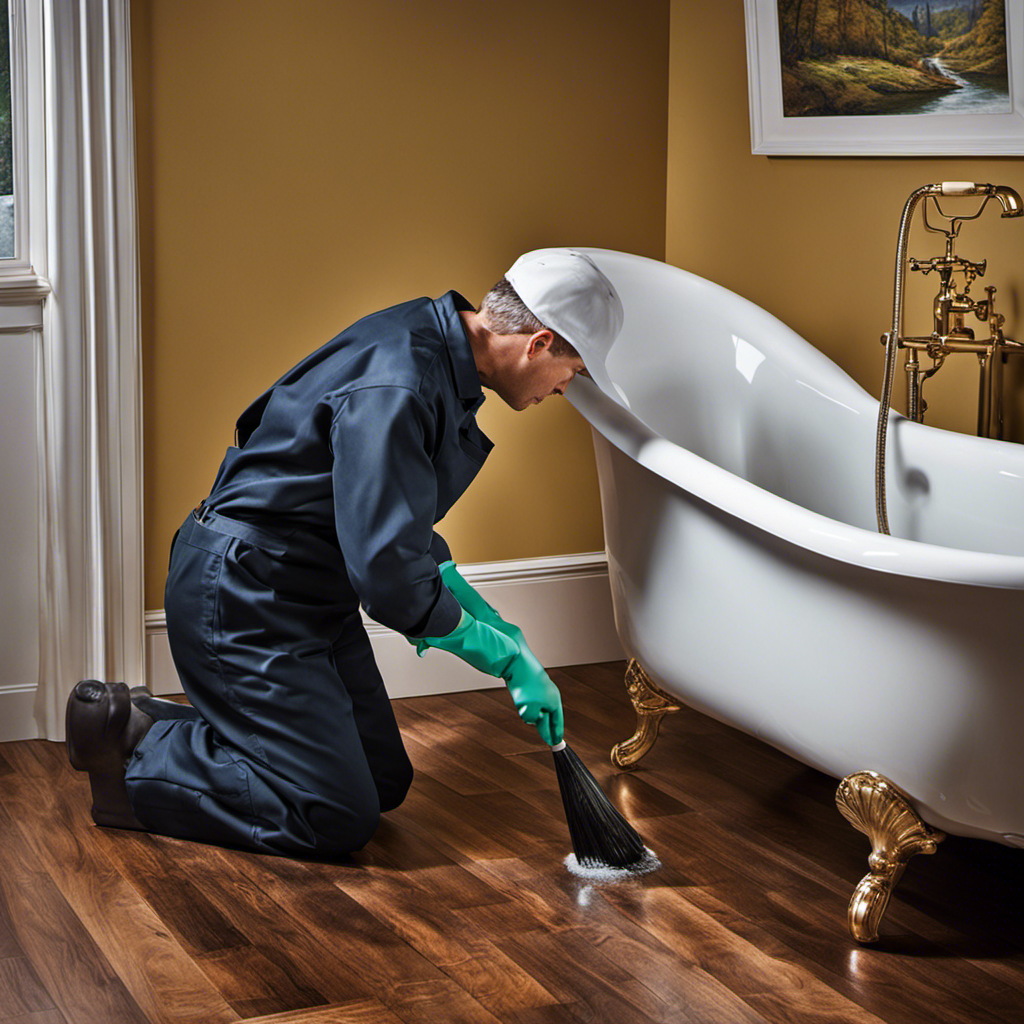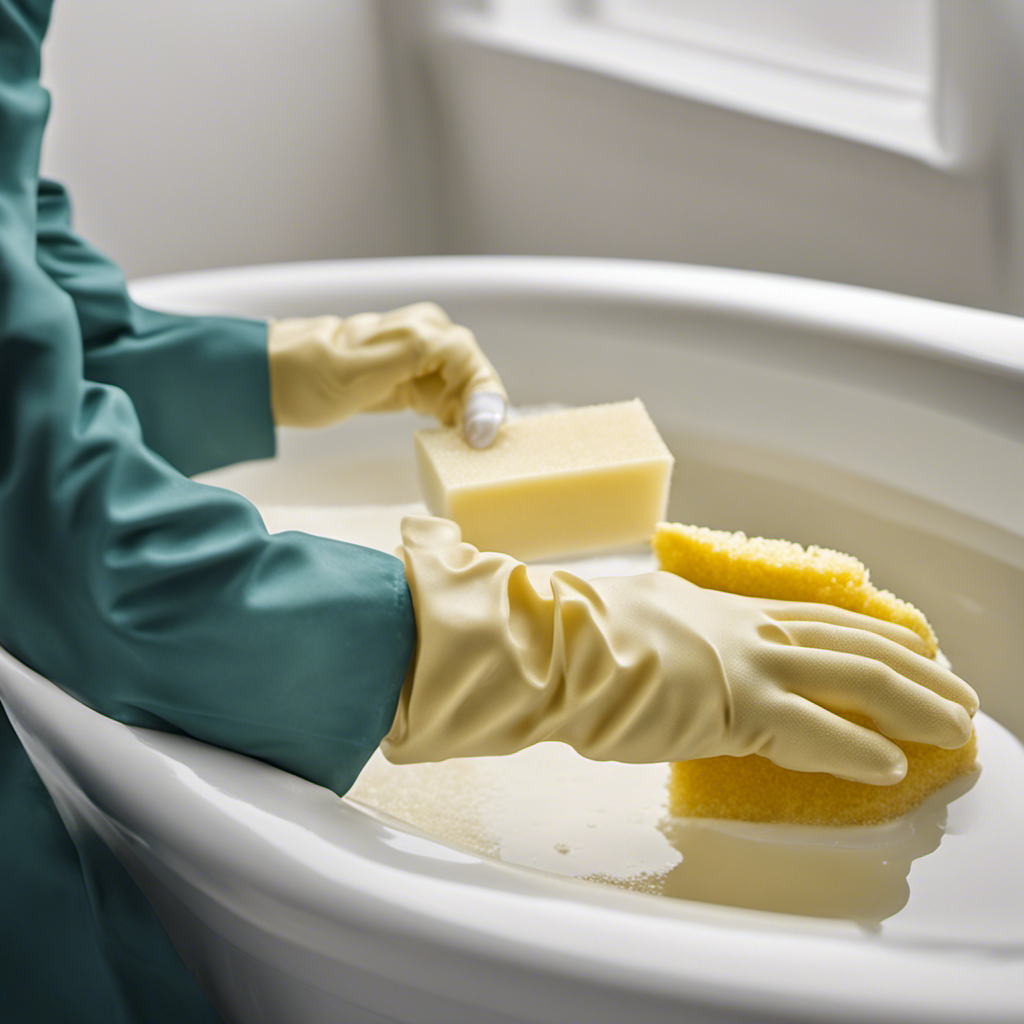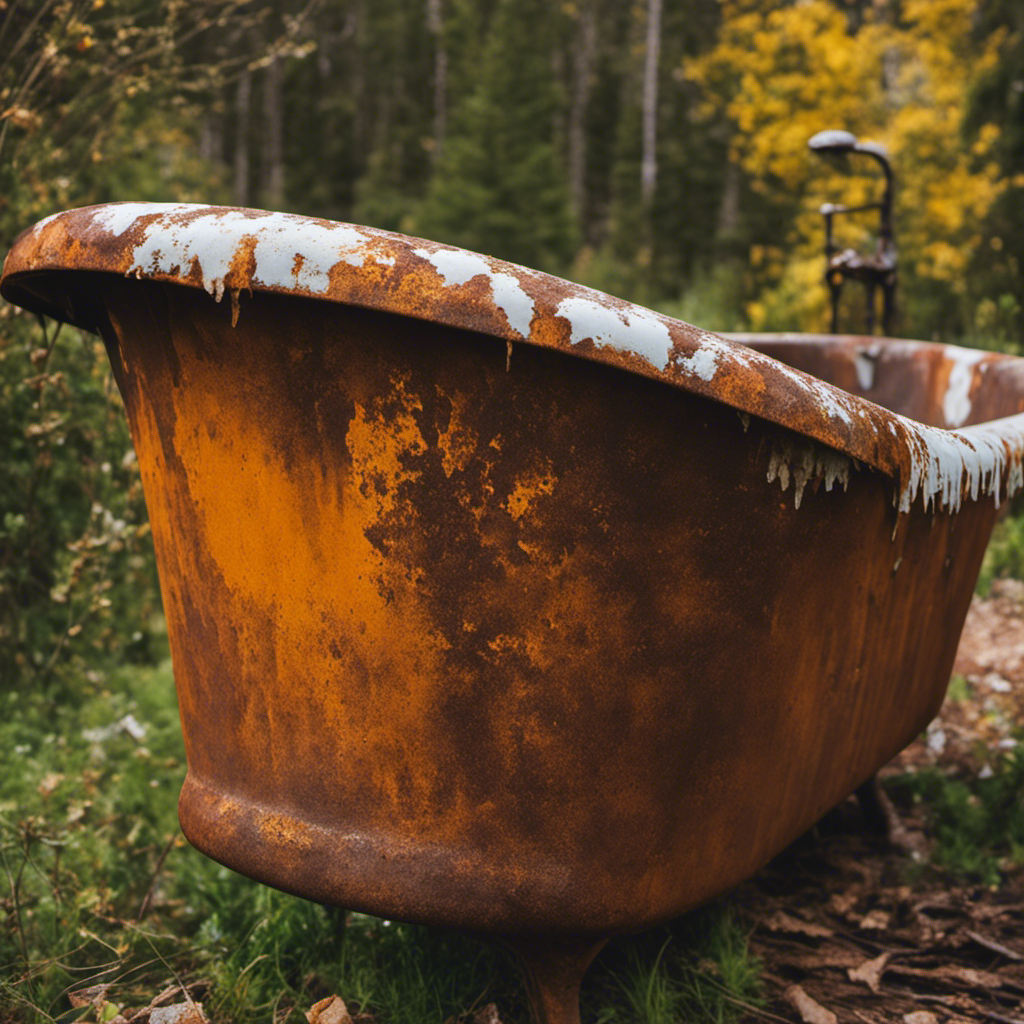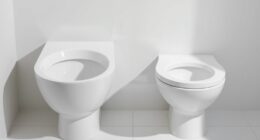Hey there, folks!
Ever had the frustrating experience of a clogged bathtub drain? Trust me, I’ve been there, and it’s no fun at all.
But fear not, because I’m here to share my tried-and-true methods for clearing that pesky clog.
In this article, I’ll guide you through the process step by step, from identifying the cause to preventing future clogs.
So grab your tools, roll up your sleeves, and let’s get that drain flowing smoothly again in no time!
Key Takeaways
- Hair accumulation and soap scum are common causes of bathtub drain clogs.
- Tools such as plungers, drain snakes, and drain cleaners are essential for effective removal of clogs.
- Proper removal of hair and debris is crucial for preventing further blockages.
- Safer alternatives to chemical drain cleaners include natural remedies like baking soda and vinegar.
Identifying the Cause of the Clog
Now, you’ll want to figure out what’s causing the clog in your bathtub drain. Diagnosing clogged pipes can be a daunting task, but with a little know-how, you can identify the problem quickly and efficiently.
One of the most common household causes of a clogged bathtub drain is hair accumulation. Over time, strands of hair can get caught in the drain, creating a blockage.
Another common culprit is soap scum and residue. As soap is used during bathing, it can build up along the walls of the pipes, eventually causing a clog.
Additionally, other items such as small toys, jewelry, or even excess toilet paper can find their way into the drain, leading to a blockage.
Gathering the Necessary Tools and Materials
When it comes to tackling a clogged drain, having the right tools is essential. From plungers to drain snakes, there are a variety of drain cleaning tools that can help you effectively clear the blockage.
Additionally, choosing the right materials, such as drain cleaners or natural alternatives, can make a significant difference in the success of your drain cleaning efforts.
Essential Drain Cleaning Tools
You’ll need a few essential drain cleaning tools to effectively clear a clogged bathtub drain. Here are three must-have items to get the job done:
-
Plunger: A plunger is a versatile tool that can be used for various drain cleaning techniques. To clear a clogged bathtub drain, place the plunger over the drain and create a tight seal. Then, vigorously plunge up and down to dislodge the clog.
-
Drain snake: A drain snake, also known as a plumbing auger, is a long, flexible tool that can reach deep into the drainpipe to remove stubborn clogs. Insert the snake into the drain and rotate it to break up and remove the clog.
-
Drain cleaner: A chemical drain cleaner can be used for minor clogs caused by hair and soap scum buildup. Follow the instructions on the product carefully, as some cleaners may require dilution or a waiting period before flushing the drain. Remember to wear gloves and avoid mixing different drain cleaning products to prevent dangerous reactions.
Choosing the Right Materials
To effectively choose the right materials for your drain cleaning needs, consider factors such as durability, compatibility, and effectiveness.
When it comes to buying options, there are several common mistakes that people make. One mistake is purchasing cheap, low-quality drain cleaning products that may not effectively remove clogs or could even damage your pipes.
Another mistake is using materials that are not compatible with your specific type of drain. For example, using a chemical drain cleaner on a septic system can be harmful and cause further issues. It’s important to carefully read product labels and choose materials that are specifically designed for the type of drain you have.
By avoiding these common mistakes, you can ensure that you choose the right materials to effectively clean your drains and prevent future clogs.
Now, let’s move on to the next step: removing hair and debris from the drain.
Removing Hair and Debris From the Drain
Start by using a pair of rubber gloves to remove hair and debris from the drain. This is an important first step in clearing clogged pipes and preventing further blockages. Here are three key items to keep in mind when removing hair and debris from the drain:
-
Use a wire hanger: Straighten out a wire hanger and create a small hook on one end. Insert the hook into the drain and gently pull out any hair or debris that may be blocking the flow of water.
-
Use a plunger: If the blockage is stubborn, a plunger can be used to create suction and dislodge the clog. Place the plunger over the drain and push down firmly, then pull up quickly. Repeat this motion several times until the water starts to drain.
-
Use a drain snake: A drain snake is a flexible tool that can be inserted into the drain to break up and remove clogs. Insert the snake into the drain and rotate it clockwise while pushing it further into the pipe. Once you feel resistance, rotate the snake counterclockwise to pull out the clog.
If these methods do not work, it may be time to consider professional drain cleaning services.
Using Chemical Drain Cleaners
If you’re dealing with a stubborn blockage, using chemical drain cleaners can be an effective solution. These cleaners are formulated to dissolve and remove clogs caused by hair, soap scum, and other debris in your bathtub drain. They work by using powerful chemicals that break down the blockage, allowing it to be flushed away.
However, it’s important to be aware of the potential risks associated with using chemical drain cleaners. These cleaners contain harsh chemicals that can be harmful to your skin, eyes, and respiratory system if not used properly. In addition, they can also damage your pipes and plumbing fixtures over time.
Safer alternatives to chemical drain cleaners include using a plunger, a drain snake, or a natural solution made from baking soda and vinegar.
Trying Natural Remedies to Clear the Clog
Using natural remedies, such as baking soda and vinegar, can be a safer alternative to chemical drain cleaners for unclogging your bathtub drain. Not only are these homemade solutions more environmentally friendly, but they are also effective in breaking down clogs without causing damage to your pipes.
Here are three natural remedies you can try:
-
Baking soda and vinegar: Start by pouring half a cup of baking soda down the drain. Follow it up with a cup of vinegar. Let the mixture sit for about 30 minutes, allowing it to fizz and break down the clog. Finish by flushing the drain with hot water.
-
Salt and boiling water: Mix half a cup of salt with a pot of boiling water. Pour the mixture down the drain and let it sit for a few minutes. The salt will help dissolve the clog, and the hot water will flush it away.
-
Lemon and hot water: Cut a lemon in half and squeeze the juice down the drain. Follow it up with a pot of hot water. The citric acid in the lemon helps break down the clog, and the hot water flushes it away.
Preventing Future Clogs in the Bathtub Drain
To prevent future clogs in the tub, regularly remove hair and debris from the drain using a mesh strainer. This simple practice can save you from dealing with a major clog later on. Additionally, there are other long-term solutions to consider for preventing damage to your bathtub drain. One effective method is using enzymatic drain cleaners. These cleaners contain enzymes that break down organic materials, preventing them from accumulating and causing clogs. Another option is installing a hair catcher or drain cover. These devices are designed to catch hair and prevent it from entering the drain. Lastly, consider scheduling professional drain cleaning services every few years to ensure your drain remains clear and clog-free. By implementing these practices, you can protect your bathtub drain and avoid costly repairs in the future.
| Preventive Measures | Benefits |
|---|---|
| Regularly using a mesh strainer | Prevents hair and debris from clogging the drain |
| Using enzymatic drain cleaners | Breaks down organic materials and prevents clogs |
| Installing a hair catcher or drain cover | Stops hair from entering the drain |
| Scheduling professional drain cleaning | Ensures a clear and clog-free drain |
Conclusion
Well, after spending hours battling with a clogged bathtub drain, I can confidently say that I am now an expert in the art of drain clearing.
Who knew that a simple task could turn into a wrestling match? But fear not, my friends, for I have emerged victorious.
Armed with tools and chemicals, I waged war against the hair and debris that had taken residence in my drain. And now, as the water flows freely once again, I can bask in the irony of it all.
The battle may have been tough, but the satisfaction of a clear drain is oh so sweet.










